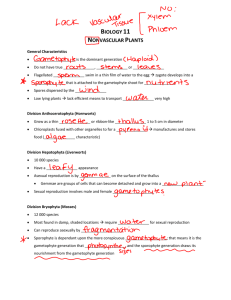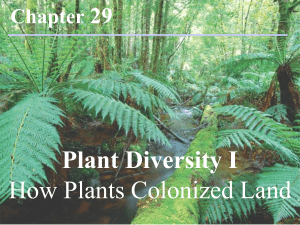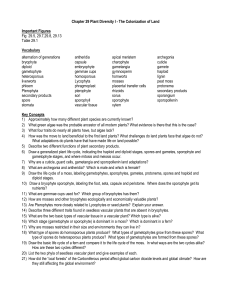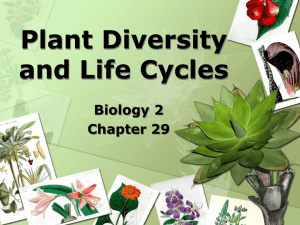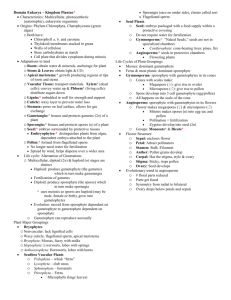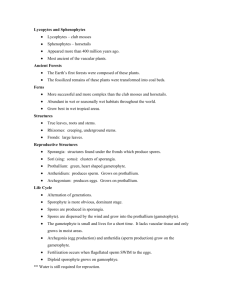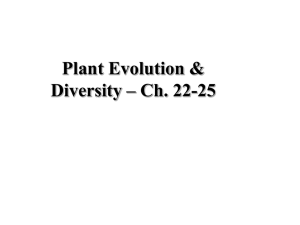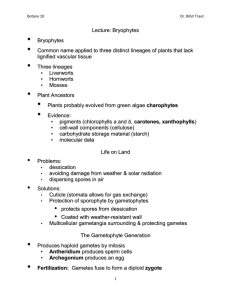Labs 15-17 Study Guide - S13 - Biology102-104
advertisement
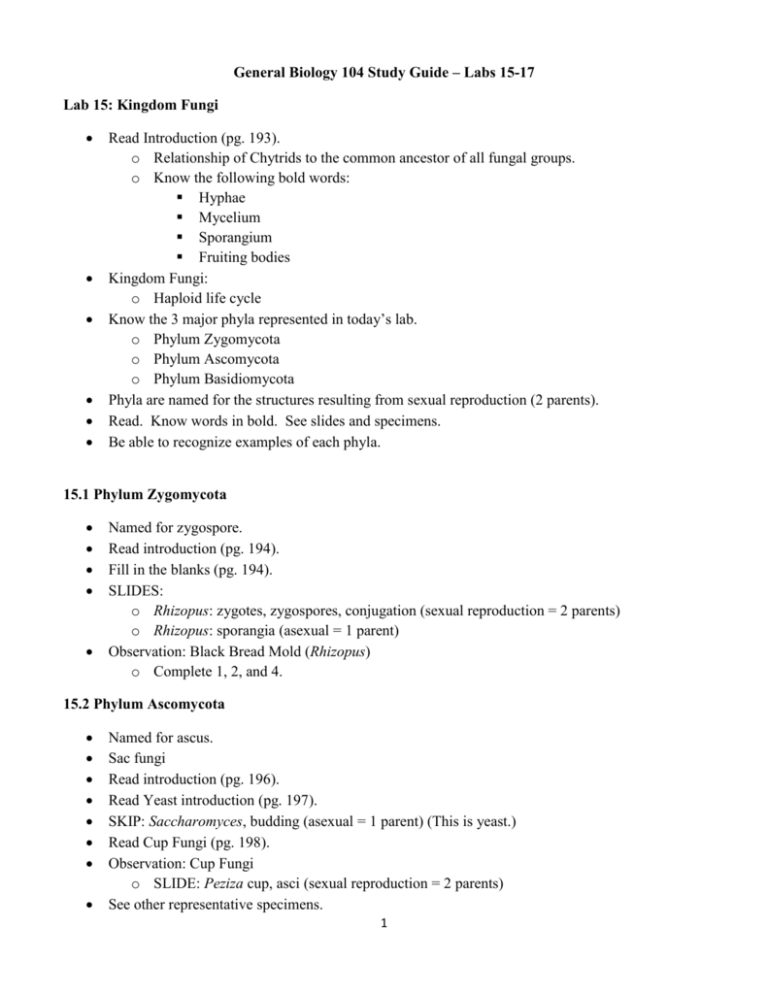
General Biology 104 Study Guide – Labs 15-17 Lab 15: Kingdom Fungi Read Introduction (pg. 193). o Relationship of Chytrids to the common ancestor of all fungal groups. o Know the following bold words: Hyphae Mycelium Sporangium Fruiting bodies Kingdom Fungi: o Haploid life cycle Know the 3 major phyla represented in today’s lab. o Phylum Zygomycota o Phylum Ascomycota o Phylum Basidiomycota Phyla are named for the structures resulting from sexual reproduction (2 parents). Read. Know words in bold. See slides and specimens. Be able to recognize examples of each phyla. 15.1 Phylum Zygomycota Named for zygospore. Read introduction (pg. 194). Fill in the blanks (pg. 194). SLIDES: o Rhizopus: zygotes, zygospores, conjugation (sexual reproduction = 2 parents) o Rhizopus: sporangia (asexual = 1 parent) Observation: Black Bread Mold (Rhizopus) o Complete 1, 2, and 4. 15.2 Phylum Ascomycota Named for ascus. Sac fungi Read introduction (pg. 196). Read Yeast introduction (pg. 197). SKIP: Saccharomyces, budding (asexual = 1 parent) (This is yeast.) Read Cup Fungi (pg. 198). Observation: Cup Fungi o SLIDE: Peziza cup, asci (sexual reproduction = 2 parents) See other representative specimens. 1 See Figure 15.3 Sac Fungi (pg. 198). Read Conidiospores (pg. 199). Observation: Conidiophores and Conidiospores (pg. 199). o SKIP: #1, 3, 4 - Aspergillus o SLIDE: #2 - Penicillium conidia, wm (asexual = 1 parent) 15.3 Phylum Basidiomycota Named for basidium. Read introduction (pg. 199). Observation: #1 - Mushrooms o See specimens. o Identify: Stalk Cap Gills o SLIDE: #2-7 - Coprinus, pileus cs (sexual reproduction = 2 parents) (Note cs – crosssection) 15.4 Fungal Diversity Know Table 15.1: Sexual and Asexual Reproduction. Fill in blanks (pg. 201). Fill out Table 15.2 with any additional fungal specimens in the back of the room. 15.5 Fungi as Symbionts Read introduction (pg. 202). o Symbiosis o Mutualism o Parasitism Read Lichens and fill in the blanks (pg. 202). Observation: Lichens o #1 - Know the 3 types of lichens. See specimens. Crustose Fruticose Foliose o SKIP #2. Read Mycorrhizae only. o SKIP: Observation: Mycorrhizae. Know answers to Laboratory Review. 2 Lab 16: Nonvascular Plants and Seedless Vascular Plants Read introduction (pg. 205). Vascular tissue = “plumbing” = tissue that conducts fluid. Read. Know words in bold. See slides and specimens. Know classification (pg. 206). Kingdom Plantae: Sporic life cycle (meiosis produces spores). Be able to identify gametophytes and sporophytes. o Gametophyte = “plant that produces gametes” (haploid) – [gametes produced by mitosis] o Sporophytes = “plant that produces spores” (diploid) – [spores produced by meiosis] 16.1 Evolution and Diversity Read. Fill in the blanks. (pg. 206-207) Read: Observation: Chara only. View Figure 16.1 and 16.2. Read about Alternation of Generations (pg. 208) and fill in the blank. 16.2 Seedless Nonvascular Plants (small) Read introduction (pg. 209). Phylum Bryophyta: mosses o Gametophyte dominant, independent o Sporophyte attached, dependent See Figure 16.4. Fill in all blanks (pg. 210-211). o SLIDES: See index card - Moss antheridia and moss archegonia o SKIP: longitudinal section through a moss sporophyte BUT still answer questions. SKIP: Liverworts 16.3 Seedless Vascular Plants (Ferns and Fern Allies) Fern Allies have a life cycle similar to ferns: o Gametophyte reduced, independent, nonvascular (small) o Sporophyte dominant, attached at first then independent, vascular (LARGER) Read introduction and fill in blanks (pg. 212). Observation: Lycophytes o Phylum Lycophyta o Read introduction (pg. 213). o Observe specimen(s) – Lycopodium (terminal strobili) o SKIP: Spike Mosses Observation: Pteridophytes o Phylum Psilotophyta 3 Whisk ferns – Psilotum (dichotomous branching). Answer questions and see specimen(s). o Phylum Sphenophyta Horsetails - Equisetum (terminal strobili). Answer questions and see specimen(s). Ferns o Gametophyte reduced, independent, nonvascular (small) o Sporophyte dominant, attached at first then independent, vascular (LARGER) Sori on underside of fronds = clusters of sporangia o Read introduction (pg. 215-217). Fill in blanks. o See Figure 16.13-Fern Life Cycle. o Observation: Fern Sporophyte and Gametophyte (pg. 217-219). Complete and see specimen(s). SLIDE: See index card: sorus, gametophyte (prothallus) DEMO: gametophyte with young sporophyte (identify parts) See all specimens. Know answers to Laboratory Review. _____________________________________________________________________________________ Lab 17: Seed Plants Read introduction (pg. 221). Read. Know words in bold. See slides and specimens. Kingdom Plantae: Sporic life cycle (meiosis produces spores) Be able to identify gametophytes and sporophytes. o Gametophytes = “plant that produces gametes” (haploid) [gametes produced by mitosis] o Sporophyte = “plant that produces spores” diploid) [spores produced by meiosis] 17.1 Life Cycle of Seed Plants Read and fill in blanks (pg. 222). Sporophyte dominant, independent, vascular Gametophyte GREATLY reduced (internal), dependent, nonvascular Compare 17.1 and 17.2. 17.2 Gymnosperms = “naked seeds” Read (pg. 223). Cycads o Read introduction. o See specimen (Cycas). Ginkgoes 4 o Read (pg. 224). o See Ginko biloba: See twig, leaves, seed Gnetophytes o Read only. o No specimens available. o Photos on pg. 225 are Ephedra (above) and Welwitschia (below) Conifers o Read (pg. 225). o See Figure 17.3-Pine Life Cycle. o Pine trees Read and fill in blanks (pg. 227). Recognize: pine twigs (needles in bundles), pollen cones, seed cones, naked seeds. (See index cards on table). See DEMO slide: pine pollen Pine Life Cycle: Know ONLY: Cycle may take 2 years or more to complete. Gametophytes are tiny, mostly internal. Know structures listed above. Read (pg. 228-229). 17.3 Angiosperms = flowering plants: (WILL DO MORE ON THIS GROUP LATER but for now do the following exercises.) Read Table 17.1: Monocots vs Eudicots (dicots) Flower Dissection: o Do Obersvation: A Flower – Steps 1-7. (Will do next week.) Know answers to Laboratory Review. 5
